How can we begin our day with harmony in the world? Balinese tradition of daily offerings is a simple and deep way to create positive blessings with Nature, to invoke the forces in the seen and unseen world.
A profound deeper meaning infuses Bali’s traditional offering. Called Canang Sari, daily offerings of flowers and leaves are prepared according to ancient rules, to maintain the delicate balance between all the elements of the earth.
Keramas Sacred River Village in Bali offers visitors a glimpse into the spiritual gifts of Bali. When our lives are in harmony with the elements of nature, our life is good. We can be happy and live without stress. Humans have the gift of free will, which requires great care. When our lives are out of balance with Nature, everything we think and do is then tainted with that misunderstanding, thus creating problems.
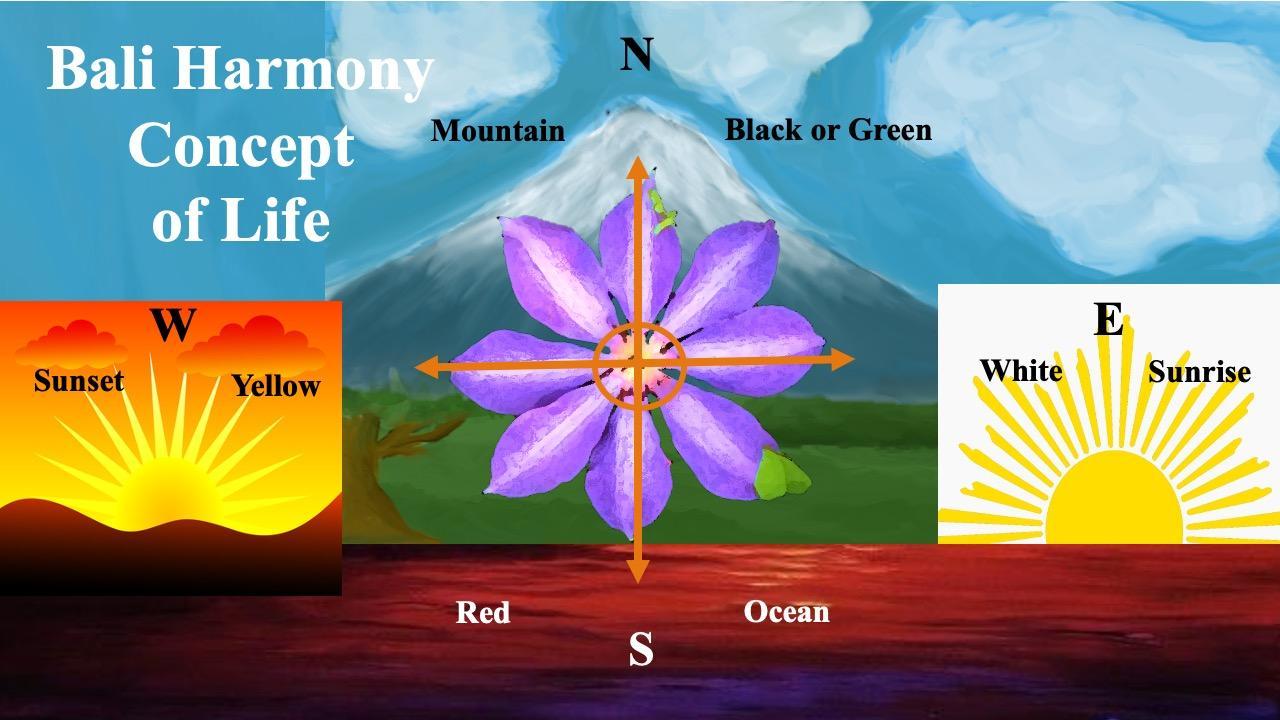
To respect all the spirits of the harmonic concept, the Balinese people make a gift for daily life every day. The Canang Sari is offered with prayers as a way to protect our lives, to invite goodness and avoid problems before they arrive. The offering is prepared using the four cardinal elements and their colors.
- North is the mountain, which is black or green, symbolizing fertility.
- South is the ocean, which is always warm, active, full of life, fire, red color.
- East is the Sunrise, white color, birth and beginnings.
- West is the Golden Sunset, prosperity, and endings.
The Four Directions
Since ancient times in Bali, two powerful aspects of nature are the mountain and ocean. As the two cardinal points in North and South they form a vertical line called the Water Line. This vertical line connects Water and Mountain, symbolizing respect between human and nature spirits of the environment. The top half of the line that moves up from the center connects humans to God. The lower half of the line connects humans to water, fire, and the ocean.
The horizontal line from East to West is called the Sun Line or the Life Line. A person is born in the East, travels up the mountain of life, and eventually comes down the mountain in the West, which represents yellow prosperity, sunset, and death. The East half of the horizontal line represents harmony with the nuclear family. The West half of the line symbolizes harmony with neighbors and the larger community.
The central circle represents the circle of life of humanity, ever eternal, which connects the vertical and horizontal lines. It means we live in perfect balance between God, nature, family and neighbors.

This practice is rooted in ancient Shamanic traditions many centuries before Hindu times. Bali’s pre-Hindu religion is sometimes called Tirtha, meaning sacred. Some call it Shiva Buda, recalling a time when God was incomprehensibly powerful even beyond concepts.
This offering is in the shape of a human being in meditation: head, body, and feet in lotus prayer position. In this way we show respect for all the spirits living with us in our life. The head at the top indicates spirit, the middle square is the body, and a triangle at the bottom represents Nature. When we choose the flowers for the offering, we arrange them according to the color for each cardinal direction.
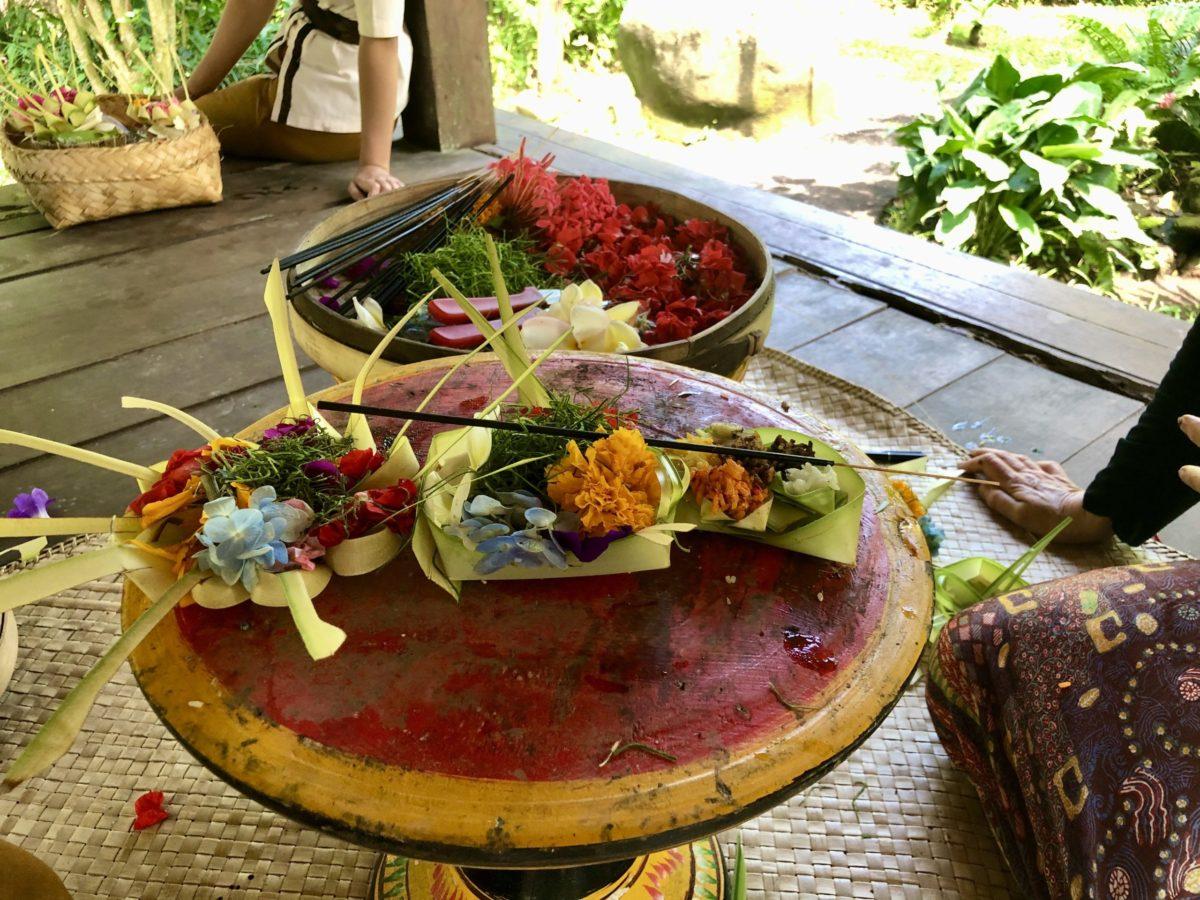
In the offering above, we made the head on the left, the body in the middle, and the bottom triangle on the right. Then we chose flowers according to the cardinal colors. For the head and body, we chose black (or green) for North, yellow for South, white for East, and red for South. The center can be mixed colors.
The bottom triangle is filled with five colors of cooked rice: South has red rice for ocean (can be made by mixing turmeric with lime). West is yellow for prosperity (with turmeric). North represents mountain using black rice or white rice colored with coffee. The East has white rice. In the center, the four colors of rice are mixed.
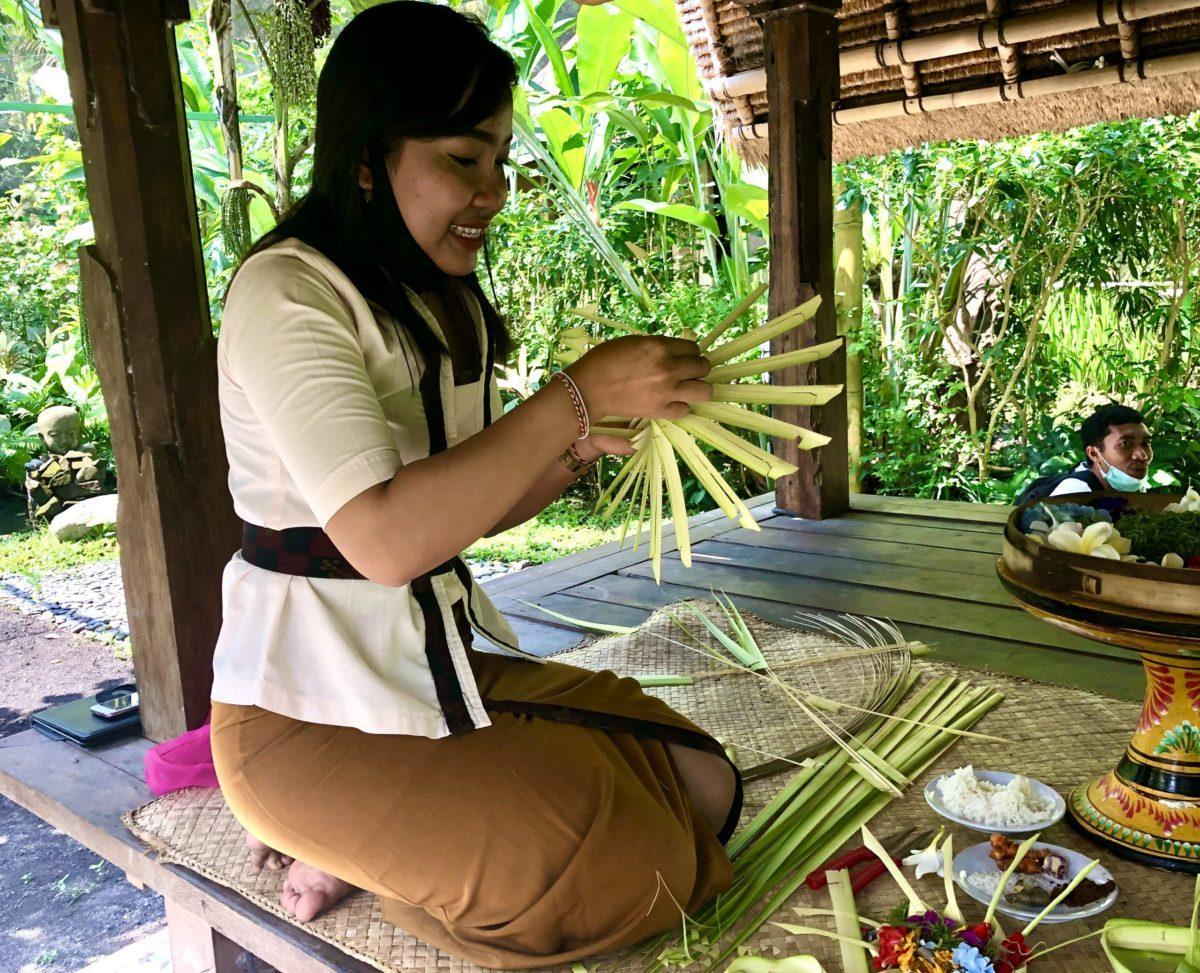
Putu is showing me how to weave coconut leaves to make the container for the offering. Weaving strips into a circle, she clips them together with little sticks. She’s very skilled and in a few moments her container is finished. The Canang Sari is prepared only by women, as the female is considered a carrier of spiritual energy. Making an offering is a very important skill for a young girl to learn. Only when she is proficient at making the offering is she is ready to marry.
Europeans coined the term “Hinduism” to include ALL traditions practiced in India. Balinese call themselves “Hindus, however it is quite different from Indian Hinduism. Balinese “Hinduism” is a mixture of different cultures, especially Indian. It is said that this faith arrived in Bali 1,000 to 1,500 years ago. Other beliefs particular to Bali include:
- Buddhism.
- Ancestor cults, the reverence of past ancestors.
- Animistic beliefs footed in ancient shamanism.
Balinese believe in Karma and Reincarnation. Balinese Hinduism has no ‘untouchable caste’. And it has no child marriages. Arranged marriages are not uncommon. Balinese Hindus worship the trinity of Brahma, Shiva, and Vishnu. Their world is populated by other gods and demons. For example, the most important one is the Dewa, the ‘ancestral gods’ of Bali. There are other local gods for Earth, fire, water, mountains, fertility, rice, and technology.
Balinese describe their early religions as three, preceding the arrival of Islam and Christianity:
- Agama Diwa (= ‘Shiva religion’).
- Agama Buda (= ‘Buddha Religion’).
- Agama Bali (= ‘Balinese religion’).
A traditional Balinese family tries to have four children to maintain harmonic balance. The first is called Wayan, corresponding to the red ocean. The second is called Made, representing the West, yellow color, and family prosperity. The third child is called Komang. He or she represents the North, responsible for the mountain area. The fourth child is called Ketut, responsible for the white area or the family spirit. Having four children will maintain all four spiritual points, which is very important in a happy life.
Many families use these names 1st, 2nd, 3rd, and 4th for their children. Hence Wayan, Made, Komang, and Ketut are some of the most common Balinese names. Family names are not used in Bali, and are even seen as a kind of colonial domination designed to control lineage and caste by last name. People wished to be free to forge their own destiny rather than be forever limited by the fate of the family, thereby carrying old problems forward into the future.
To indicate male or female, a prefix is added to the name. For male, add I. For female Ni. So as the second child, my name is NiMade. My Balinese teacher is the fourth child Ketut, so he is called Iketut.
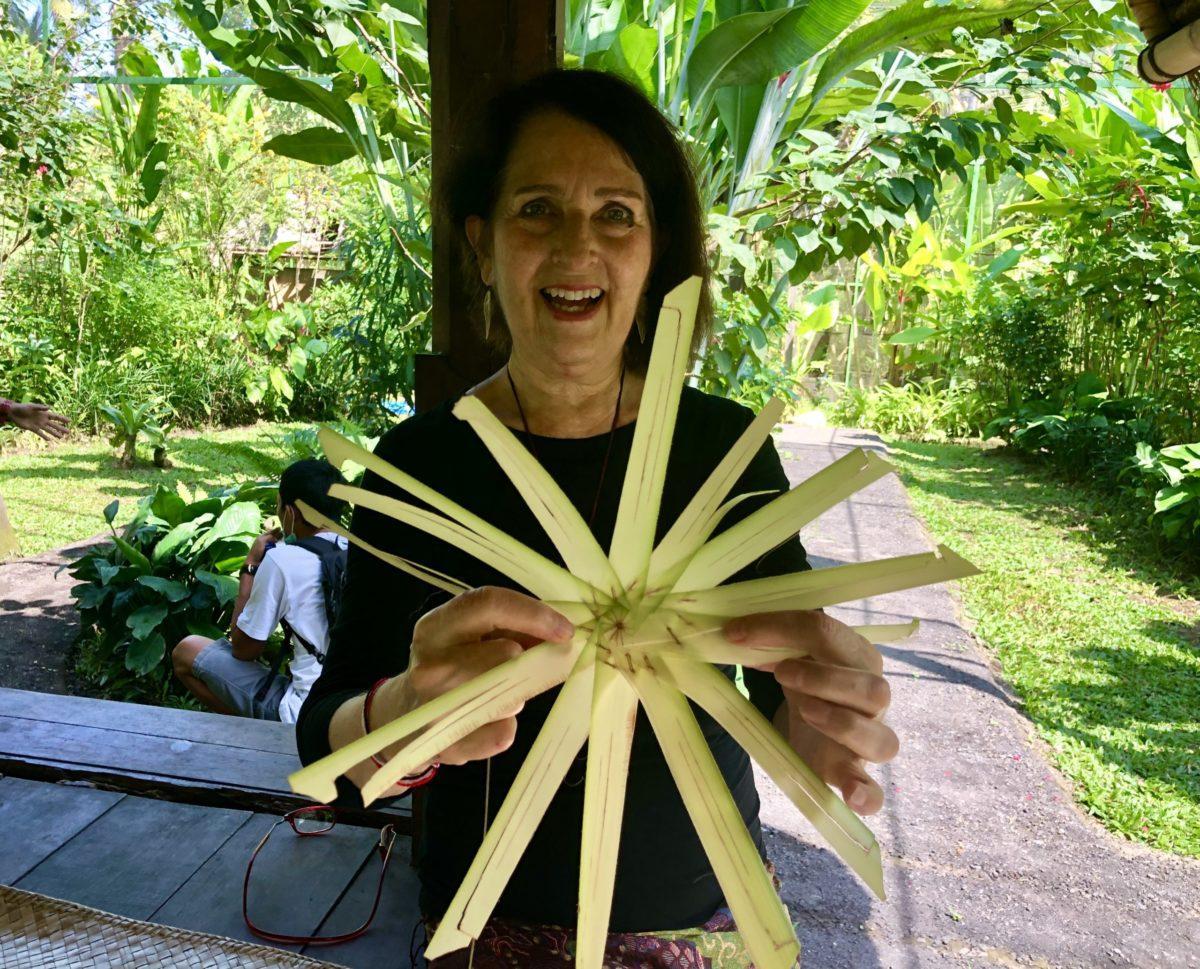
I finished weaving a circle of coconut strips and clipped them with coconut sticks. Next we connect the coconut strips to make curved flower petals around the center. Then we will fill it with flowers and rice.
All Balinese sacred ceremonies and temples follow these basic four directions. For example, even the traditional family living compound is built along these lines to support the balance of life, like a kind of Balinese “Feng Shui” design for a harmonious life. Thus the kitchen fire is in South red area. Yellow color indicates gold and prosperity in the West. On that side we build a small house for our grandparents, who have already come down from the mountain and will soon pass on. The North building is larger like a mountain where parents and children live. In the East white area the family temple houses spiritual energy.
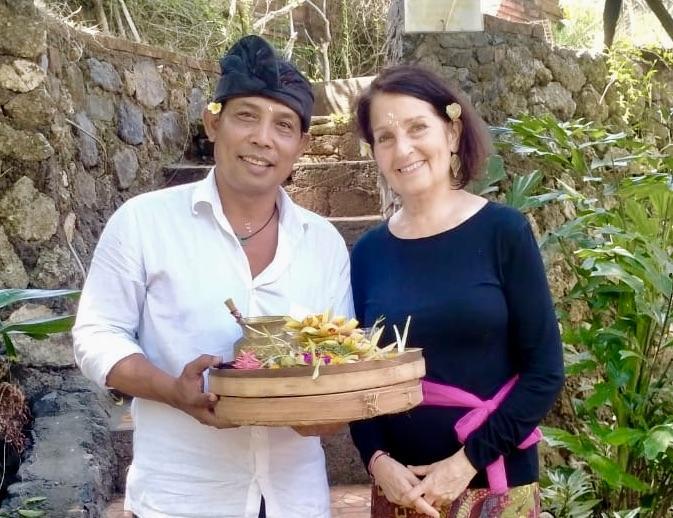
Ketut at Keramas Sacred River Village holds the Canang Sari offering that we so carefully made. We completed a ceremony in the beautiful 7th century temple here. I am so honored to participate and learn about Canang Sari and Balinese spiritual traditions.
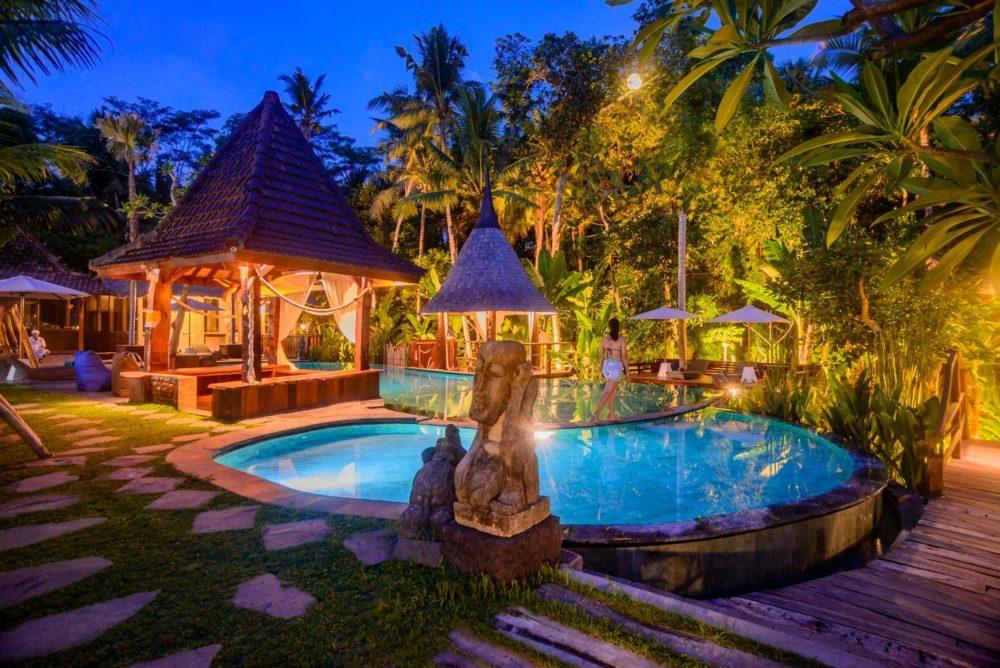
Our swimming pool is located at the center of a circle of private houses, each one in traditional Bali style.
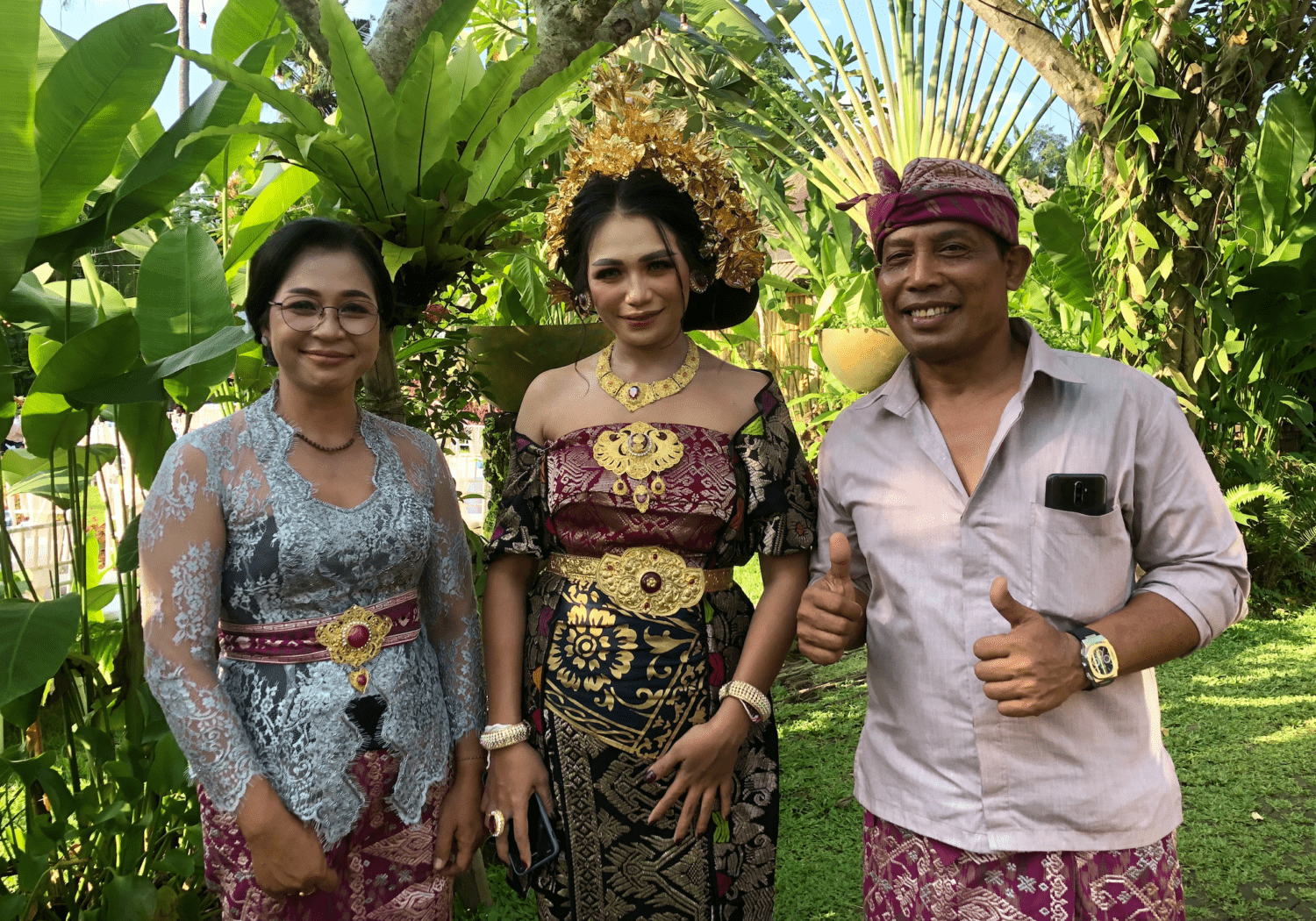
Keramas Sacred River Village is ready to sponsor a Balinese wedding, authentic spiritual retreat, or vacation, for those with genuine interest in harmony, nature, and the beauty of Bali.
www.keramassacredriver.com
Facebook: keramassacredriver
KERAMAS SACRED RIVER
CONTACT INFO


